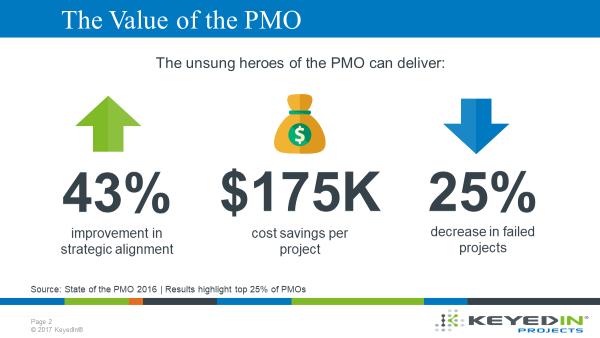- Home
- Blog Center
- The 5 Most Important Business Benefits of a Successful PMO
The 5 Most Important Business Benefits of a Successful PMO
Enterprises struggle with uncovering how to best use PPM to accelerate their business benefits and fulfil business strategies. The program management office (PMO) can demystify project management processes and ensure both a strategic and tactical approach that is holistic and gets the most value from your projects. Here are five business benefits your PMO can quickly attain when effectively aligning PPM and PM initiatives with corporate strategy.
1. Improve visibility
Visibility that allows program management office (PMO) leaders to transparently predict risk to project outcomes might be the single most impactful task your PMO fulfills. Once visibility gets everyone aligned behind real-time facts, you’re more likely to be aligned behind overall PMO goals. Often times the project managers know the inner workings of projects and where the bottlenecks are but aren’t able to show that information or prove to executives what the problems are. Having visibility into the portfolio enables everyone to be on the same page and make decisions based on accurate data rather than gut feels. Storing all project data in one location will save time and money in searching for information or not having critical project data. Centralizing projects into one system of record will provide key stakeholders a full picture of the business, not just what they care about. Improving visibility into where time and resources are being spent is the first step to ensuring they are where they need to be.
2. Top down strategic alignment in the PMO
Visibility into the portfolio of projects is the first step to strategic alignment. Understand all the projects in flight and all the requests coming to you. Then understand what the goals of the business are and which projects support those goals. Align the portfolio priorities with corporate objectives from the top down to deliver more value from your project selections. Score, prioritise and plan the most valuable projects and business cases with full transparency among stakeholders. When your portfolio of projects is strategically aligned to the goals of the organization, you will drive more impact with your time, resources and value provided. Your enterprise will be able to capitalize on opportunities for innovation, control costs by balancing resource utilization around the most valuable activity and manage current and future budget risk.
An example of this can be seen from a leading provider of collocation, technology and cloud computing services, Pulsant, as they were able to achieve strategic alignment. They reported that having visibility of all projects in the portfolio allowed them to be a lot more efficient and the ability to track projects from beginning to end without losing track of things, getting off course or jumping from one “high priority” item to the next. Looking at the whole supply and demand for a project, the financial data, and all resource requirements including role-based forecasts, they were able to better utilize resources and become more efficient at the portfolio level. Using true project portfolio management strategies ensured Pulsant that they can manage and invest in the right resources in the right projects, further enabling them to meet the critical reporting objectives and enhance strategic business growth.
3. Bottom up, execution driven alignment
Your planning practices will promise value, but you also need bottom up alignment to deliver on that promise. Connecting strategy with execution is not always as easy as it sounds. Do you have multiple demands and requests plus an array of programs already in flight? PMO leaders know the importance of project collaboration and task management to the overall successful of the project and ultimately the portfolio. Your PMO needs to understand the linkages and dependencies between various projects in the portfolio, and will be able to learn what will derail your productivity.
Additionally, all these project can come in a variety of project structures – Agile, Scrum, Hybrid, Kanban and Waterfall – and need to be executed in a way that best fits the project. Various project methodologies can hinder your project efficiency if not managed correctly. Don’t let the methodology dictate your performance, rather let it enhance your effectiveness and improve your value contribution. Your enterprise will benefit from being able to manage all types of projects and able to execute according to the needs of the project—agile and waterfall timelines and budgets can be managed very differently at the project level but can be rolled up in a single PMO view.
4. Deliver value beyond ‘on-time, on-budget’
What exactly are the strategic PMO’s performance indicators if not on-time and on-budget? Getting deliverables out on time might be the most you hope for now, but how do you know that you are executing the right projects, in the right way and with the right people?
Most project managers get caught up managing projects based on their ability to be delivered on time and on budget; but that just isn’t good enough in today’s competitive market. Meeting goals, becoming outcome-oriented and delivering on stakeholder expectations will surpass traditional KPIs in the long run. Ensuring you are measuring toward the right KPIs through proper portfolio management will empower assessment of projects against business needs, allocating resources effectively, and executing projects to gain the most impact for the company. You can be on-time, of course, to save weeks of effort and open bandwidth for high-potential work. However, with program planning that goes beyond on-time, on-budget, you identify the strategic value drivers of your business. Then, working from this playbook, you can provide a more strategic function than simply execution. Get and keep a seat at the table by speaking the same language as your corporate sponsors—proving aligned activities rather than high-on-time percentages for every low-value project on your list.
5. Promote the portfolio-level value and optimization
Value on the portfolio level, not necessarily on the project level, means you can easily stop low-value projects and in-flight project additions that are next on-deck but not necessarily the highest, strategic priority. As business partners, your PMO teams will need to exhibit strategically-impactful results. When the PMO can communicate, collaborate and innovate using the best PPM practices, your PMO teams are an irreplaceable asset. The PMO can be flexible and powerful using modelling to get a handle on risks, identify and conquer constraints, while shortening and eliminating critical paths. With PMO governance and templates you can stop reinventing the wheel on every project and move away from manual and labour-intensive data management. Continuous feedback and optimization allow the PMO to get better every time a project is completed and the portfolio is delivered.
6. Proving business value
Your program management office’s existence may depend on how well you are able to increase the awareness of the value of the PMO and your PPM process among stakeholders. Every day you will proactively protect the most strategic project arrays with predictive, consistent actions. Make the right kind of strategic decisions that allow you to respond with agility or have the appropriate hard data about resource constraints.
With automated tracking and dashboards, you will be able to show accurate, relevant data and easily customize reporting to show ROI of everything you do—from assigning tasks to maximizing resource management.
Your decisions are backed up by metrics and your metrics prove your PMO has enhanced value to fulfilling business requirements. Stakeholders see hard data proving exactly how your program management office delivers tangible and meaningful strategic power. The graphic below demonstrates the value of the PMO.

To achieve these results, you not only need good people and processes, but also supporting technology. Yes, the people, processes and technology message has been pushed by software vendors for years. However, in an environment where poor project selection or even failure could have a catastrophic effect on the business involved, it’s still amazing to see how many PMOs are trying to manage project selection, prioritization, resource capability planning and deliverables via error-prone spreadsheets. Smart companies are changing this recipe for disaster.





